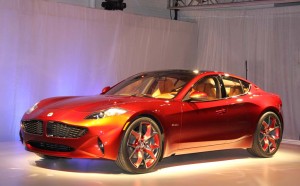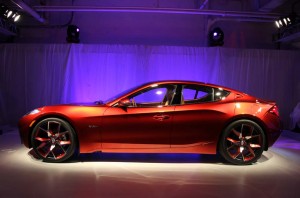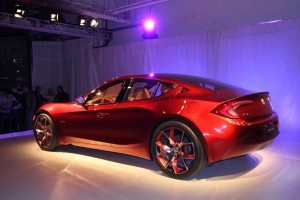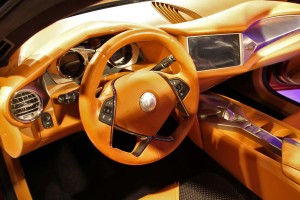Henrik Fisker, founder of the eponymous Fisker Automotive, was clearly searching for something new to reveal during an evening news conference the night before the formal opening of the 2012 New York Auto Show. The problem is that much of what he had hoped to say – and then some – leaked out in the days leading up to the event.
The most important detail confirmed by the Danish designer-cum-automaker was that the second Fisker product line will be dubbed the Atlantic if it ever gets into production. Make that “when” it gets to production, Fisker asserted, insisting that the California start-up’s problems locking down a Department of Energy loan it thought it already had will not stop its ambitious plans.
Fisker belatedly reached market with the bigger and decidedly more expensive Karma earlier this year. But problems bringing it to showrooms led the DoE to withdraw the loan after the company had only been able to draw down about 35% of it. While new Chief Executive Officer Tom LaSorda is continuing discussions with the government, he told TheDetroitBureau.com that Fisker Automotive is moving ahead with alternative plans to raise money privately to replace the DoE funds.
It pulled in about $100 million in the last month, he revealed, bringing to over $1 billion the private equity Fisker Automotive has so far raised. But company sources hinted that the firm will still need $200 million to $300 million more to get the Atlantic – previously codenamed Project Nina – into production. That could still happen, as planned, by 2013, but for now Fisker isn’t setting a new target.
Nonetheless, “We will build it,” proclaimed a determined Henrik Fisker, as the spotlight illuminated the new coupe-like 4-door Atlantic.
The prototype – which he insisted is essentially the final production model – bears a strong resemblance to the current Karma model, though they share few common parts. The coupe-like shape all but conceals the rear door, their handles hidden in the rear pillar. The “spider” roof itself uses an unusual design to enhance its strength while providing maximum rear headroom, Fisker suggested. And one of Atlantic’s more striking feature is its headlights, which are almost “ice-like,” the one-time Aston Martin designer said.
Few details were offered about the electric drive system and the range-extending internal combustion engine, which is designed to kick in when the vehicle’s batteries are discharged. The only thing the management team would confirm is that Atlantic will use a small engine provided by BMW, rather than the GM-supplied four-cylinder gas engine in Karma.
During the New York reveal, company officials tried to put the best face possible on recent events, though LaSorda, a former CEO of Chrysler, acknowledged “We’ve had our fair share of challengers…especially in the last few weeks.”
Besides the problems with the DoE loan and the late launch of Karma, the maker was embarrassed when a car it provided influential Consumer Reports magazine for testing failed to start. It later discovered that was the result of manufacturing defects at battery supplier A123.
That firm is covering the cost of the recall of Karma’s lithium-ion battery packs – and recalls at several other unidentified customers. But LaSorda acknowledged it was a black eye that, if it hasn’t cost Fisker sales has clearly led some potential customers to wait before signing on the dotted line.
But the news isn’t entirely bad. The Karma has received kudos from other influential media outlets, such as Britain’s Top Gear. And the maker has now sold 700 of the plug-ins, with a downsized goal of reaching the 4,000 mark in 2012.
As for plans for the Atlantic? Can’t say, Fisker executives repeated. Many seemingly fixed details are now in the air. Even where it might be built. “We’re considering all the options,” said LaSorda, when asked if the maker is staying with the old GM plant it purchased in Delaware.
Officials did hint that the company is now working up “several” variants of the small car, and that that the initial, coupe-like sedan will likely go for about half the price of the Karma, which would put it somewhere in the $50,000 range if – make that when, sorry – it ever reaches production.




